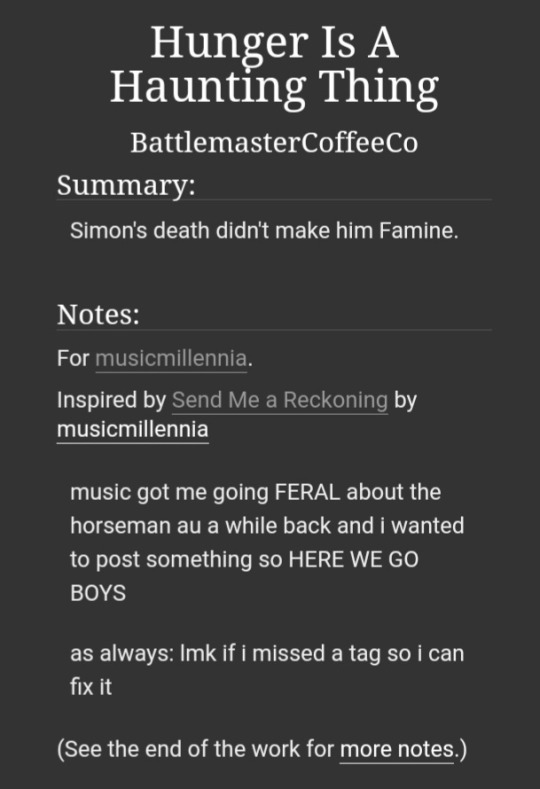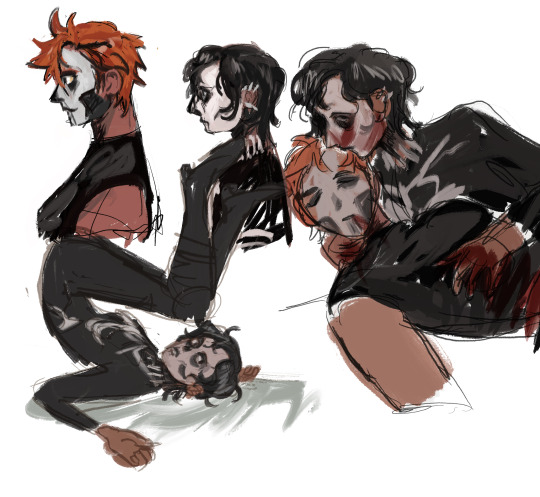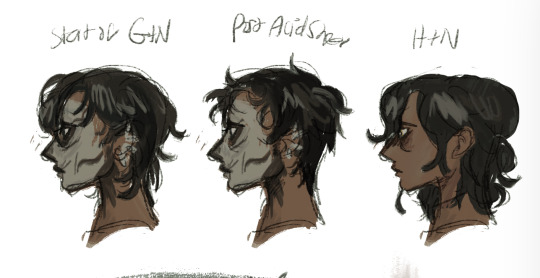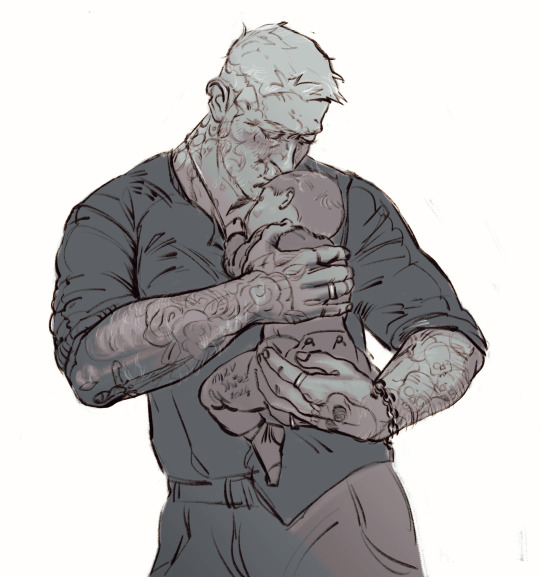Text
Sometimes I'm a "I can only write on my phone" person and sometimes I'm a "if I do no have a computer I don't even know how to form words" person and it's changes from hour to hour
11 notes
·
View notes
Text
@ fic authors what do you personally consider a successful fic? What’s the bar?
81K notes
·
View notes
Text
do you ever just … picture a whole scene, a whole fanfiction in your head, you know how to place every single word of the english dictionary that you need (or your language dictionary), you know how to structure your sentences, you know just what your characters are going to say to each other and then… and then you just open microsoft word.
7K notes
·
View notes
Text
HEY WHATS UP FUCKS--
ahem excuse me. I'm just excited to announce NEW FIC DROP
for the old friends: sorry, its actually not Star Wars
it's fucking CoD because I got the brainrot smthn fierce
anyway here's a four horsemen au short that will hopefully become a small series


11 notes
·
View notes
Text
Reblog to give the person you reblogged from the ability to finish their WIPs
65K notes
·
View notes
Text
Another worldbuilding application of the "two layer rule": To create a culture while avoiding The Planet Of Hats (the thing where a people only have one thing going for them, like "everyone wears a silly hat"): You only need two hats.
Try picking two random flat culture ideas and combine them, see how they interact. Let's say taking the Proud Warrior Race - people who are all about glory in battle and feats of strength, whose songs and ballads are about heroes in battle and whose education consists of combat and military tactics. Throw in another element: Living in diaspora. Suddenly you've got a whole more interesting dynamic going on - how did a people like this end up cast out of their old native land? How do they feel about it? How do they make a living now - as guards, mercenaries? How do their non-combatants live? Were they always warrior people, or did they become fighters out of necessity to fend for themselves in the lands of strangers? How do the peoples of these lands regard them?
Like I'm not shitting, it's literally that easy. You can avoid writing an one-dimensional culture just by adding another equally flat element, and the third dimension appears on its own just like that. And while one of the features can be location/climate, you can also combine two of those with each other.
Let's take a pretty standard Fantasy Race Biome: The forest people. Their job is the forest. They live there, hunt there, forage there, they have an obnoxious amount of sayings that somehow refer to trees, woods, or forests. Very high chance of being elves. And then a second common stock Fantasy Biome People: The Grim Cold North. Everything is bleak and grim up there. People are hardy and harsh, "frostbite because the climate hates you" and "stabbed because your neighbour hates you" are the most common causes of death. People are either completely humourless or have a horrifyingly dark, morbid sense of humour. They might find it funny that you genuinely can't tell which one.
Now combine them: Grim Cold Bleak Forest People. The summer lasts about 15 minutes and these people know every single type of berry, mushroom and herb that's edible in any fathomable way. You're not sure if they're joking about occasionally resorting to eating tree bark to survive the long dark winter. Not a warrior people, but very skilled in disappearing into the forest and picking off would-be invaders one by one. Once they fuck off into the woods you won't find them unless they want to be found.
You know, Finland.
23K notes
·
View notes
Text
Fanfic writers are like crows. If you give them treats (comments) they will bring you shiny things (fanfic)
21K notes
·
View notes
Text
ear’s guide to writing stab wounds
disclaimer!!!: this isn’t to be used as actual medical advice there isn’t enough information at hand to properly treat someone, this is just for writing.
hemostatic (blood clotting) control is the number one priority. minor bleeding can be controlled with direct pressure to the wound. moderate bleeding may require a compression bandage as well as direct pressure. severe penetrating wounds or a nicked artery means wound packing will be necessary as well as direct pressure.
types of stab wounds:
- blunt stab wound means whatever object caused the trauma wasn’t sharp or wasn’t moving fast enough so the skin tears.
- penetrating stab wounds go deep into the skin and into the muscle.
- superficial stab wounds don’t go too far under the skin and look worse than they actually are.
steps to treatment:
1. if the object is still inside the person’s body do not remove it unless it’s to the groin, neck, or axillae (armpit) and the bleeding is hard to control.
2. remove person’s clothes to check for any other wounds and keep the area clear.
3. keep an eye on blood pressure and airway.
4. the wound type and location changes how the rest of treatment will follow.
location:
head: direct pressure is mainstay. head wounds also bleed more than any other part of the body. has the highest mortality rate.
face: severe wounds to the face means the patient has to be seated forward to keep blood out of the airway.
neck: direct pressure is mainstay. if the airway can be secured and is absolutely necessary, wound packing can be applied.
arms: depending on the severity, any of the three treatments can be used.
legs: depending on the severity, any of the three treatments can be used.
abdomen: damage to organs is highly likely. direct pressure should be applied first while surveying if the object was long enough to damage an organ. if so, wound packing may be necessary.
chest: if the wound is deep enough it can cause open pneumothorax (‘sucking’ chest wound) a seal needs to be placed over the wound to keep air from getting inside. if this isn’t done in time the affected lung will collapse.
back: can typically be treated with only direct pressure. wound packing is rarely necessary.
neck, chest, abdomen, and pelvis wounds should never be packed unless absolutely necessary.
treatment types:
direct pressure: key to any wound. can be done with whatever is available even if that means the medic needs to use their own body weight.
tourniquets: applied to the limbs. typically not applied for more than thirty minutes. in some cases, they can be left on for hours, keeping the phrase “life over limb” in mind. complications with tourniquets like nerve damage or ischemia (no blood circulation) are rare. don’t apply over a joint and apply above the wound.
wound packing: done with standard gauze and or hemostatic dressing
wound packing steps:
1. control the bleeding with pressure. use anything available even if it means t shirts or a knee.
2. place a gloved finger inside the wound too apply initial pressure. this will hurt like a bitch. also gives you an idea of what direction the blood is coming from so gauze can be used more accurately.
3. begin packing the wound with gauze. keep pressure on the wound with finger while wrapping gauze around another finger and pushing it in the wound.
4. keep packing the wound until no more gauze can fit in, and then keep direct pressure on for at least three minutes.
5. after the three minutes, use something like a bandage wrap to keep the gauze secure inside the wound.
6. splinting the area to keep it immobilized may be vital to keep the hemorrhage from restarting
7. if bleeding continues medic has to decide if they need to take out gauze and reapply with new gauze or apply more direct pressure. this is usually done by how long it takes to get to further treatment. the longer the wait the more of an incentive it becomes to repack the wound. if it’s just down the road then apply pressure.
most likely complications:
hypoxia, shock, and hypothermia are complications that need to be watched for and treated immediately if they occur.
hypoxia:
occurs when a region of the body doesn’t have enough oxygen in the tissue. can lead to organ damage, brain and heart damage being the most dangerous.
symptoms include: tachycardia (rapid heart rate), difficulty breathing, confusion, shortness of breath, anxiety, headache, and restlessness.
severe symptoms include: bradycardia (slow heart rate), extreme restlessness, and cyanosis (blue or purple tint to skin).
treatment: oxygen
shock:
life threatening condition where the body doesn’t have enough blood volume to circulate through itself. if it goes on for long enough, organ damage and death may occur.
symptoms: rapid, slow, or absent pulse, heart palpitations, rapid shallow breathing, lightheadedness, cold clammy skin, dilated pupils, chest pain, nausea, unfocused eyes, confusion, anxiety, and loss of consciousness.
treatment: if they’re not breathing, cpr is required. if they are breathing, lay on back and raise feet a foot off the ground to keep blood in the vital organs.
blood transfusion and fluids once in a hospital setting.
hypothermia: occurs when the body is losing heat quicker than it can produce. the more blood that’s lost the more likely hypothermia is to occur.
symptoms: differ based on severity
hypothermia:
in mild hypothermia: shivering, exhaustion, clumsiness, sleepiness, weak pulse, tachycardia (rapid heart rate), tachypnea (rapid breathing), pale skin, confusion, and trouble speaking.
in moderate hypothermia: bradycardia (slow heart rate), bradypnea (slow breathing), slurred speech, decline in mental function, shivering slows down, hallucinations, cyanosis (blue or purple tint to skin), muscle stiffness, dilated pupils, irregular heart rate, hypotension (decreased blood pressure), and loss of consciousness.
in severe hypothermia: shivering stops, hypotension (low blood pressure), absence of reflexes, compete muscle stiffness, fluid builds up in lungs, loss of voluntary motion, cardiac arrest (heart stops beating), coma, and death.
treatment: covering with a blanket, hat, and jacket, adding external heat like a hot pack, and if severe and in a hospital setting, warm fluids via iv, warm oxygen, and or a machine to warm the blood in the body.
if you have any questions feel free to ask! i plan on making a guide to gunshot wounds and a more in depth guide to hypothermia later.
560 notes
·
View notes
Text
It's always
"When will fanfic writers update their stories?"
And never
"Does this fanfic writer have adequate enrichment to engage in writing behaviours?"
Fanfiction writers (Scriptor fictus) are intelligent animals who need plenty of enrichment as well as encouragement! If they're stuck in poor conditions (e.g. have studies, work, have to actually write to have something written) then they require the proper enrichment to engage in more healthy behaviours, like writing. Remember, due to poor breeding and socialisation, over half of all fanfic writers suffer from low self confidence and executive dysfunction so take care of them!
Give your fanfic writers proper care. Fanfiction writers are a life long commitment.
32K notes
·
View notes
Note
how’s roach holding up

The COUNTRY, Sanderson
10K notes
·
View notes











